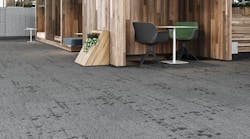Or read the transcript below:
[Start transcript]
Hello, everyone and welcome to another addition of I Hear Design. This is Robert Nieminen, editor-at-large of Interiors+Sources. And I’m coming to you from Chicago after the first full day of NeoCon.
Normally, I’d be tempted to report on the day’s events, maybe talk about what trends I already see emerging from the dozens of showrooms we visited today. And I will likely post a wrap up after the fact in the days ahead, just to report on what’s been happening at the show. So, keep an eye out for that for sure.
However, what I want to talk about in this podcast is really about innovation and evidence-based design. Because a lot of times, we come to trade shows and hear the word “innovation” thrown around a lot.
But more often than not, it seems to me that a lot of companies may be trying something new or different for them, but it doesn’t always really qualify as innovation. That’s not to knock anyone who’s doing something that may be a bit out of their comfort zone.
On the contrary, we support that kind of risk taking. However, it doesn’t mean that what’s new is always innovative, necessarily.
So, when I see something that’s truly unique and groundbreaking, it’s something that I definitely wanted to talk about and share with you guys.
And since arriving here on Sunday, there’s one product in particular that I keep coming back to that I think truly fits the bill of innovation and being completely different that’s really worth talking about.
So, what I think what makes the Mohawk Group’s Relaxing Floors Collection such a standout from the show so far is the fact that it’s steeped in evidence-based research.
The story behind this product, just very quickly, is to me just so fascinating. I spoke with the designers and researcher of the modular flooring product, and Martin and Anastasija Lesjak of 13&9 who worked closely with Richard Taylor, the professor of Physics, Psychology and Art at the University of Oregon and the founder of Fractals Research. They created this next generation of flooring solutions of the Mohawk Group.
What was so cool was that Professor Taylor’s research was originally commissioned for NASA to study the effect that isolation from the earth had on astronauts who had spent time in space. And that research had been largely unnoticed in the design world anyway until now.
Essentially, the collection is a kind of experiment between art and science and human-centered design based on these fractal patterns they uncovered in nature that have been translated into an algorithm for carpet patterns.
So, in other words, they identified what types of patterns in nature draw the human eye and why. So, they looked at things like form and density and mapped those patterns and studied how they could be translated into a medium like a carpet to mimic the eye’s movement in response to natural surroundings.
The resulting in designs, which have been abstracted from the algorithm have been shown to reduce stress by as much as 60% and contribute to the overall wellbeing of occupants. And not to mention, they’re beautiful carpets.
So, what I loved so much about this collection is not just that it was tied to the current trends by Ophelia and evidence-based design, but ultimately what 13&9 and Mohawk have managed to accomplish is to create a product that has a quantifiable impact on human health.
I just thought that was a fantastic potential application for this product.
So, if the claims about the calming effect of this pattern and this carpet has on people proves to be true, then the applications for this science just seem to be far reaching. And that to me is really exciting.
So, that’s why I’m focusing this podcast on this one particular product rather than the typical day one roundup. Because I think if the Mohawk and crew are truly onto something, then this could be a gamechanger for the industry.
It would mean that evidence-based design isn’t just some lofty idea that we all talk about and that we hope carries a little more weight than anecdotal evidence in terms of the impact that design has on occupants.
This type of approach to product design could truly transform the way we think about and design products all together.
Because if we truly believe in the power of design to change the world, we’ve gotta be able to stand behind it with more than just vague suggestions about improving people’s lives. We need evidence-based research that looks deeply and critically at theories like biophilia and translates those concepts into measurable and beautiful patterns that capture our attention and make us feel better about the places we inhabit.
Well, that’s it for now. But stay tuned for more from NeoCon this week and visit our website for plenty of coverage. And thanks for listening everyone.
[End transcript]
Listen to more from Mohawk: Breaking Down the Differences in Resilient Flooring

